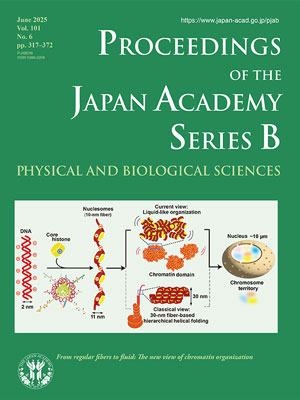About the Cover
Vol. 101 No. 6 (2025)
How 2 meters of human genome DNA are organized in the cell as chromatin has long been a fundamental question in cell biology. Negatively charged DNA is wrapped around positively charged core histones to form nucleosomes (left). For many decades, a string of nucleosomes (10-nm fiber) was believed to fold into regular 30-nm chromatin fibers and then into progressively thicker fibers in a hierarchical manner—forming the textbook model of chromatin structure (lower middle).
However, Maeshima et al. have challenged this classical paradigm (See the review article in this issue, pp. 339–356). Instead of static, regular fibers, chromatin in living higher eukaryotic cells forms a condensed domain organization that exhibits liquid-like properties (upper middle). These domains serve as functional units of chromatin that regulate access to DNA for key processes such as transcription and replication. On the right, these domains are shown to be assembled into a chromosome, which occupies a chromosome territory within the cell nucleus (shown in different colors).
The emerging “liquid-like domain” model highlights the viscoelastic nature of chromatin—locally fluid and dynamic to increase DNA accessibility, yet globally stable at the chromosome scale to preserve genome integrity. This model provides a conceptual framework for understanding how chromatin organization contributes to genome functions in space and time.
Yoshinori Ohsumi
Member of the Japan Academy




